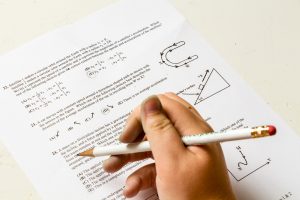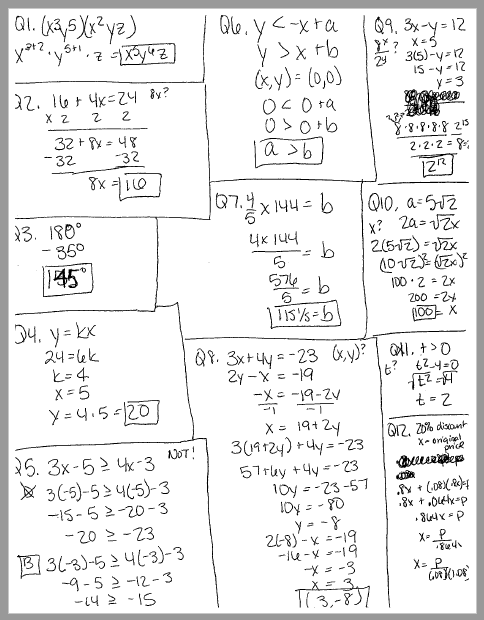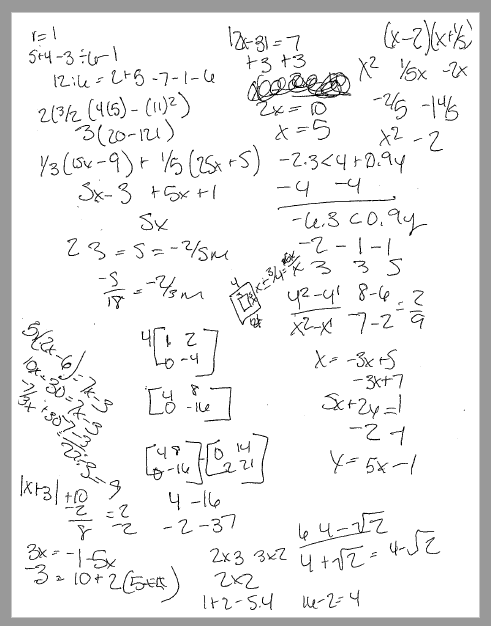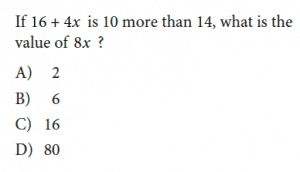
5 Top Ways to Prevent Silly Mistakes on Math Tests
Most of us have experienced the frustration of studying really hard for a math test, only to lose valuable points because of silly mistakes!
Whether you plugged in the wrong number, misread the question, or simply made a bubbling mistake on your Scantron, minor errors and silly mistakes can cost you big on a test. They can be the difference between an A or a B on a school exam, a 690 or a 750 on the SAT, or acceptance or rejection on an admission test.
That’s why it’s important to stop silly mistakes in their tracks.
Here are 5 top ways from MEK’s expert teachers for you to boost your math scores by eliminating careless mistakes.
#1. Change your mindset.
 The higher the stakes for your test (state exams, SAT or ACT, high school admission test), the more important it is to earn all the points you can!
The higher the stakes for your test (state exams, SAT or ACT, high school admission test), the more important it is to earn all the points you can!
The real mistake students often make is not taking these errors seriously.
Here are some typical reactions we hear from students:
- “Oh man, I just made a stupid mistake. I know the right answer is actually 7.”
- “I was rushing and misread the question. Now that I look at it again, I get it.”
And as educators, our response is generally along the lines of:
- It doesn’t matter that you know the right answer is 7 now because you got in wrong when it counted. Why?
- Why did you rush?
It’s human to make a mistake; everyone does it! There’s no need to beat yourself up about it. However, you do want to take time to critically think about the error.
Every time you make an avoidable mistake, take time to reflect and ask yourself “Why did I make that mistake?” Then come up with a good strategy that will prevent you from making that mistake in the future. The best way to eliminate silly mistakes is to practice good habits that prevent or catch the mistake before you turn in the test. For more advice on developing good habits, check out our blog on the top traits of successful math students.
Pro Tip!
If you’re preparing for admission exams, review or resolve your old practice problems or tests. Try to see if there is a pattern in your careless errors.
By locating patterns, you can learn about your current bad habits, take steps to create good habits and boost your score! For more guidance on acing admissions tests, check out our High School Admissions Prep programs and SAT Prep courses.
#2. Reduce the strain on your brain to prevent silly mistakes.
When you’re taking a test, especially a long test, your brain is using much more energy than it is when you’re watching TV or talking to a friend. It gets tired and works slower, which leads to more mistakes.
 One of the biggest ways to save mental energy during a math test is to write everything down. When you calculate a problem in your head, it requires more concentration. You’re tiring your brain – faster!
One of the biggest ways to save mental energy during a math test is to write everything down. When you calculate a problem in your head, it requires more concentration. You’re tiring your brain – faster!
Doing a problem in your head will cost you time because if you get confused halfway through solving the problem, you can’t refer to the steps you’ve already taken on your paper. You have to start all over.
It will cost you points because you’re much less likely to catch a careless calculation error that’s in your head, than you are when you write it down.
Pro Tip!
Here are other key ways to keep your brain sharp and reduce errors:
Get 7-9 hours of sleep the night before a test.
Studies show lack of sleep reduces your ability to maintain focus, remember things, and multitask!
Practice problems often.
When you practice a lot of math problems, you build up mental endurance, the same way running every day builds up physical endurance.
Study mathematical concepts thoroughly.
When you only have a murky idea of how to attack a problem or the principles behind it, you will exert more high-level concentration than when you have a concept down cold. MEK has programs to help middle schoolers and high schoolers master mathematical concepts at their grade and course difficulty level.
Stay calm and carry on.
If you’re taking a test and are filled with anxiety, you might feel like it’s harder to focus on the question or remember strategies.
Stay calm by taking a few deep breaths and skipping problems that immediately freak you out, and telling yourself positive mantras like:
- “I can do this.”
- “It’s just a test. It doesn’t define me.”
- “I’m prepared and capable.”
- “I don’t need to be perfect.”
#3. Avoid silly mistakes by writing neatly and orderly.
Always use a good pencil and eraser and be self-disciplined about writing legibly.
 You don’t want to lose points because you misread your own handwriting or didn’t fully erase a number!
You don’t want to lose points because you misread your own handwriting or didn’t fully erase a number!
Organize your work, so you can quickly refer back to it. Write each step taken directly above the previous step, so that if you need to refer back, you can quickly understand how you arrived at your answer and catch any mistakes made.
Check out this video by Director of High School Admissions Test Prep & Subject Prep, Mr. Pranav Gupta, on more steps to organize your work when solving math problems.
Pro Tip!
If you are using scratch paper, use it wisely.
Always write the question number you are working on, complete your calculations, and then draw a neat box around that work, so you can easily see which work is going with which question.
This will prevent you from filling your scratch paper with so much work from so many different questions that you don’t know which calculations match which questions.
Do this:

Not this:

#4. Read the question carefully to prevent silly mistakes.
This tip may seem obvious, but so many silly mistakes come from not actually answering the question!
For example:

In the above SAT question, I might automatically solve for x, and pick the answer A) 2.
But that’s not answering the question! It asked for the value of 8x, so the answer is C) 16.
If you find yourself making this type of mistake often, make yourself always box or underline key words in the question to ensure that you are actually answering the question. In the above example, you would underline value of 8x to remind yourself you are solving for 8x, not x.
Lastly, after you solve, check one more time before moving on that you have answered the actual question.
Remember, good habits are the key to catching or preventing silly mistakes.
Pro Tip!
When you are preparing for high school admissions or the SAT, you might become accustomed to seeing the same types of problems over and over again. So when you take a test, you might skim the question and feel like you know what it’s asking.
Don’t! Make yourself slow down. You never know when a math problem features an unexpected twist that affects your answer.
5. Always re-check your work to prevent silly mistakes.
This advice is probably the one you’ve heard the most because it works! If you are self-disciplined enough to double-check your work, you will catch your own silly mistakes before you turn in the test.
 Some students may feel like they don’t have the time to do this, but if you follow tips #2, #3, and #4, checking your work becomes much easier.
Some students may feel like they don’t have the time to do this, but if you follow tips #2, #3, and #4, checking your work becomes much easier.
You can quickly check your neatly written, well-organized calculations, and double check that you have answered the question, didn’t confuse any units, decimal points, or negative signs, or make any simple calculation mistakes.
Pro Tip!
For more advanced students, be on the look out for misleading answer choices.
These are especially common in the SAT or ACT, SSAT or ISEE admissions tests, or math competition tests. These tests often have answer choices that are designed to trick you. The first step to avoiding them is to be aware that they are there. Review old practice problems and try to pick out the answer choices that are trying to take advantage of a silly mistake. If you can become adept at spotting these traps while studying, you’ll be more likely to spot them on a test!
Here’s an example from a middle level ISEE admission test:

To solve this problem, I simply need to input the values for B, P, and S and solve for A:
A = 2(12) + (16)(3)
A= 24 + 48
A = 72
The answer is A) 72. However, look at the other answers, and try to catch the silly mistake the test is hoping you’ll make. For example B) 62 is hoping that when you add 24 + 48, you’ll forget to carry the 1, and get 62. C) 43 is hoping that instead of multiplying P and S (16 x 3 = 48), you’ll mistakenly add them instead (16 + 3 = 19), which when you then add to 24 will get you 43.
The more you can identify trap answers, the more you will eliminate these simple calculation mistakes.
Taking the next step

By practicing these good habits, you can eliminate silly mistakes and boost your score! For more expert help from MEK’s experienced teachers, check out our math courses for every grade:
- Grades 4-8: MEK Learning Circles Math Courses – Ace tests and assignments by enrolling in our PSM and ONS courses. We offer both virtual and on-site options.
- Grades 4-7: MAPC – Train your math skills with our math competition team.
- Grades 5-8: H.S. Admissions – Ace the SSAT, ISEE, HSPT, or BCA admissions test by learning test-taking strategies.
- Grades: 9-12: College Test Prep – Earn top scores on the SAT with personalized guidance from our expert teachers.
Call 855-346-1410 or visit our Contact page to sign up today.
We can’t wait to hear from you!



